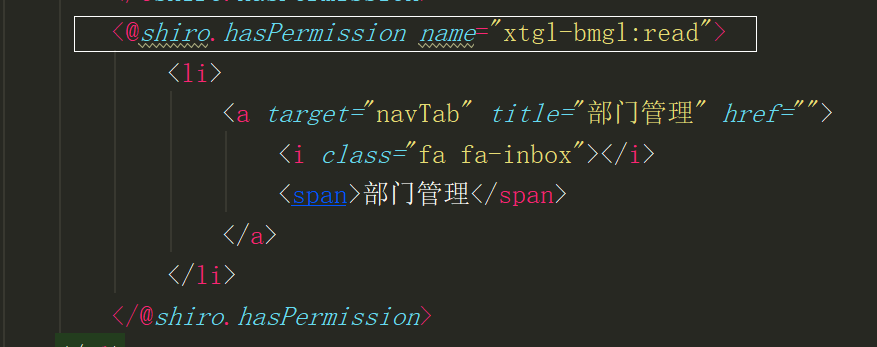本文是接着上篇博客写的:Spring boot 入门(三):SpringBoot 集成结合 AdminLTE(Freemarker),利用 generate 自动生成代码,利用 DataTable 和 PageHelper 进行分页显示。按照前面的博客,已经可以搭建一个简单的 Spring Boot 系统,本篇博客继续对此系统进行改造,主要集成了 Shiro 权限认证框架,关于 Shiro 部分,在本人之前的博客(认证与Shiro安全框架)有介绍到,这里就不做累赘的介绍。
此系列的博客为实践部分,以代码和搭建系统的过程为主,如遇到专业名词,自行查找其含义。
1.Shiro 配置类
系统搭建到目前为止,主要用到了3个配置类,均与 Shiro 有关,后期随着项目的扩大,配置文件也会随之增多。

FreeMarkerConfig:主要针对 FreeMarker 页面显示的配置,关于 Shiro 部分,为 Shiro 标签设置了共享变量
,如果不设置此变量,FreeMarker 页面将不能识别 Shiro 的标签,其主要代码如下:
1 configuration.setSharedVariable("shiro", new ShiroTags());MShiroFilterFactoryBean:设置了过滤器,当然也可以在 Config 文件里面配置过滤器,其缺点是:
在每次请求里面都做了 session 的读取和更新访问时间等操作,这样在集群部署 session 共享的情况下,数量级的加大了处理量负载。本项目后期将用到分布式,因此这里就直接将过滤器与 Config 配置文件分离,提高效率。
1 private final class MSpringShiroFilter extends AbstractShiroFilter { 2 protected MSpringShiroFilter(WebSecurityManager webSecurityManager, FilterChainResolver resolver) { 3 super(); 4 if (webSecurityManager == null) { 5 throw new IllegalArgumentException("WebSecurityManager property cannot be null."); 6 } 7 setSecurityManager(webSecurityManager); 8 if (resolver != null) { 9 setFilterChainResolver(resolver);10 }11 }12 13 @Override14 protected void doFilterInternal(ServletRequest servletRequest, ServletResponse servletResponse,15 FilterChain chain) throws ServletException, IOException {16 HttpServletRequest request = (HttpServletRequest) servletRequest;17 String str = request.getRequestURI().toLowerCase();18 boolean flag = true;19 int idx = 0;20 if ((idx = str.indexOf(".")) > 0) {21 str = str.substring(idx);22 if (ignoreExt.contains(str.toLowerCase()))23 flag = false;24 }25 if (flag) {26 super.doFilterInternal(servletRequest, servletResponse, chain);27 } else {28 chain.doFilter(servletRequest, servletResponse);29 }30 }31 32 }ShiroConfiguration:通用配置文件,此配置文件为 Shiro 的基础通用配置文件,只要是集成 Shiro,必有此文件,主要配置 Shiro 的登录认证相关的信息,其代码如下:
1 /** 2 * 设置shiro的缓存,缓存参数均配置在xml文件中 3 * @return 4 */ 5 @Bean 6 public EhCacheManager getEhCacheManager() { 7 EhCacheManager em = new EhCacheManager(); 8 em.setCacheManagerConfigFile("classpath:ehcache/ehcache-shiro.xml");
9 return em;
10 } 11 /** 12 * 凭证匹配器 13 * (由于我们的密码校验交给Shiro的SimpleAuthenticationInfo进行处理了 14 * 所以我们需要修改下doGetAuthenticationInfo中的代码; 15 * ) 16 * @return 17 */ 18 @Bean 19 public HashedCredentialsMatcher hashedCredentialsMatcher(){ 20 HashedCredentialsMatcher hashedCredentialsMatcher = new HashedCredentialsMatcher(); 21 hashedCredentialsMatcher.setHashAlgorithmName("md5");//散列算法:这里使用MD5算法; 22 hashedCredentialsMatcher.setHashIterations(1);//散列的次数,比如散列两次,相当于 md5(md5("")); 23 return hashedCredentialsMatcher; 24 } 25 /** 26 *
27 * 主文件 28 */ 29 @Bean(name = "myShiroRealm") 30 public UserRealm myShiroRealm(EhCacheManager cacheManager) { 31 UserRealm realm = new UserRealm();
32 realm.setCacheManager(cacheManager); 33 realm.setCredentialsMatcher(hashedCredentialsMatcher()); 34 return realm; 35 } 36 //会话ID生成器 37 @Bean(name = "sessionIdGenerator") 38 public JavaUuidSessionIdGenerator javaUuidSessionIdGenerator(){ 39 JavaUuidSessionIdGenerator javaUuidSessionIdGenerator = new JavaUuidSessionIdGenerator(); 40 return javaUuidSessionIdGenerator; 41 } 42 @Bean(name = "sessionIdCookie") 43 public SimpleCookie getSessionIdCookie(){ 44 SimpleCookie sessionIdCookie = new SimpleCookie("sid"); 45 sessionIdCookie.setHttpOnly(true); 46 sessionIdCookie.setMaxAge(-1); 47 return sessionIdCookie; 48 49 } 50 /*<!-- 会话DAO -->*/ 51 @Bean(name = "sessionDAO") 52 public EnterpriseCacheSessionDAO enterpriseCacheSessionDAO(){ 53 EnterpriseCacheSessionDAO sessionDao = new EnterpriseCacheSessionDAO(); 54 sessionDao.setSessionIdGenerator(javaUuidSessionIdGenerator()); 55 sessionDao.setActiveSessionsCacheName("shiro-activeSessionCache"); 56 return sessionDao; 57 } 58 @Bean(name = "sessionValidationScheduler") 59 public ExecutorServiceSessionValidationScheduler getExecutorServiceSessionValidationScheduler() { 60 ExecutorServiceSessionValidationScheduler scheduler = new ExecutorServiceSessionValidationScheduler(); 61 scheduler.setInterval(1800000); 62 return scheduler; 63 } 64 @Bean(name = "sessionManager") 65 public DefaultWebSessionManager sessionManager(EnterpriseCacheSessionDAO sessionDAO){ 66 DefaultWebSessionManager sessionManager = new DefaultWebSessionManager(); 67 sessionManager.setGlobalSessionTimeout(1800000); 68 sessionManager.setDeleteInvalidSessions(true); 69 sessionManager.setSessionValidationSchedulerEnabled(true); 70 sessionManager.setSessionValidationScheduler(getExecutorServiceSessionValidationScheduler()); 71 sessionManager.setSessionDAO(sessionDAO); 72 sessionManager.setSessionIdCookieEnabled(true); 73 sessionManager.setSessionIdCookie(getSessionIdCookie()); 74 return sessionManager; 75 } 76 @Bean(name = "lifecycleBeanPostProcessor") 77 public LifecycleBeanPostProcessor getLifecycleBeanPostProcessor() { 78 return new LifecycleBeanPostProcessor(); 79 } 80 @Bean 81 public DefaultAdvisorAutoProxyCreator getDefaultAdvisorAutoProxyCreator() { 82 DefaultAdvisorAutoProxyCreator daap = new DefaultAdvisorAutoProxyCreator(); 83 daap.setProxyTargetClass(true); 84 return daap; 85 } 86 @Bean(name = "securityManager") 87 public DefaultWebSecurityManager getDefaultWebSecurityManager(UserRealm myShiroRealm, DefaultWebSessionManager sessionManager) { 88 DefaultWebSecurityManager dwsm = new DefaultWebSecurityManager(); 89 dwsm.setRealm(myShiroRealm); 90 // <!-- 用户授权/认证信息Cache, 采用EhCache 缓存 --> 91 dwsm.setCacheManager(getEhCacheManager()); 92 dwsm.setSessionManager(sessionManager); 93 return dwsm; 94 } 95 /** 96 * 开启shiro aop注解支持. 97 * 使用代理方式;所以需要开启代码支持; 98 * @param securityManager 99 * @return100 */101 @Bean102 public AuthorizationAttributeSourceAdvisor getAuthorizationAttributeSourceAdvisor(DefaultWebSecurityManager securityManager) {103 AuthorizationAttributeSourceAdvisor aasa = new AuthorizationAttributeSourceAdvisor();104 aasa.setSecurityManager(securityManager);105 return aasa;106 }107 /**108 * ShiroFilter<br/>109 * 注意这里参数中的 StudentService 和 IScoreDao 只是一个例子,因为我们在这里可以用这样的方式获取到相关访问数据库的对象,110 * 然后读取数据库相关配置,配置到 shiroFilterFactoryBean 的访问规则中。实际项目中,请使用自己的Service来处理业务逻辑。111 *112 */113 @Bean(name = "shiroFilter")114 public ShiroFilterFactoryBean getShiroFilterFactoryBean(DefaultWebSecurityManager securityManager) {115 ShiroFilterFactoryBean shiroFilterFactoryBean = new MShiroFilterFactoryBean();116 // 必须设置 SecurityManager 117 shiroFilterFactoryBean.setSecurityManager(securityManager);118 // 如果不设置默认会自动寻找Web工程根目录下的"/login.jsp"页面119 shiroFilterFactoryBean.setLoginUrl("/login");120 // 登录成功后要跳转的连接121 shiroFilterFactoryBean.setSuccessUrl("/certification");122 //shiroFilterFactoryBean.setSuccessUrl("/index");123 shiroFilterFactoryBean.setUnauthorizedUrl("/403");124 loadShiroFilterChain(shiroFilterFactoryBean);125 return shiroFilterFactoryBean;126 }127 /**128 * 加载shiroFilter权限控制规则(从数据库读取然后配置)129 *130 */131 private void loadShiroFilterChain(ShiroFilterFactoryBean shiroFilterFactoryBean){132 /////////////////////// 下面这些规则配置最好配置到配置文件中 ///////////////////////133 Map<String, String> filterChainDefinitionMap = new LinkedHashMap<String, String>();134 // authc:该过滤器下的页面必须验证后才能访问,它是Shiro内置的一个拦截器org.apache.shiro.web.filter.authc.FormAuthenticationFilter135 filterChainDefinitionMap.put("/login", "authc");136 filterChainDefinitionMap.put("/logout", "logout");137 // anon:它对应的过滤器里面是空的,什么都没做138 logger.info("##################从数据库读取权限规则,加载到shiroFilter中##################");139 // filterChainDefinitionMap.put("/user/edit/**", "authc,perms[user:edit]");// 这里为了测试,固定写死的值,也可以从数据库或其他配置中读取140 shiroFilterFactoryBean.setFilterChainDefinitionMap(filterChainDefinitionMap);141 }2.登录认证与权限管理
主要重写了 Realm域,完成权限认证和权限管理:
1 protected AuthorizationInfo doGetAuthorizationInfo(PrincipalCollection principals) { 2 //如果没有做权限验证,此处只需要return null即可 3 SimpleAuthorizationInfo authorizationInfo = new SimpleAuthorizationInfo(); 4 String userName = (String) principals.getPrimaryPrincipal(); 5 Result<TUser> list = userService.getUserByUsername(userName); 6 if(list.isStatus()) { 7 //获取该用户所属的角色 8 Result<List<TRole>> resultRole = roleService.getRoleByUserId(list.getResultData().getUserId()); 9 if(resultRole.isStatus()) {10 HashSet<String> role = new HashSet<String>();11 for(TRole tRole : resultRole.getResultData()) {12 role.add(tRole.getRoleId()+"");13 }14 //获取该角色拥有的权限15 Result<List<TPermission>> resultPermission = permissionService.getPermissionsByRoleId(role);16 if(resultPermission.isStatus()) {17 HashSet<String> permissions = new HashSet<String>();18 for(TPermission tPermission : resultPermission.getResultData()) {19 permissions.add(tPermission.getPermissionsValue());20 }21 System.out.println("权限:"+permissions);22 authorizationInfo.setStringPermissions(permissions);23 }24 }25 }26 //return null;27 return authorizationInfo;28 }29 30 @Override31 protected AuthenticationInfo doGetAuthenticationInfo(AuthenticationToken authenticationToken) throws AuthenticationException {32 //认证登录33 String username = (String) authenticationToken.getPrincipal();34 //String password = new String((char[]) authenticationToken.getCredentials());35 Result<TUser> result = userService.getUserByUsername(username);36 if (result.isStatus()) {37 TUser user = result.getResultData();38 return new SimpleAuthenticationInfo(user.getUsername(), user.getPassword(), getName());39 }40 //return new SimpleAuthenticationInfo(user., "123456", getName());41 return null;42 }43 }2.1.登录认证
首先创建一个前端登录界面,做一个简单的登录 Form 表单

点击登录即想后台发送一个请求,必须是Post请求,否则Shiro不能识别,认证部分主要在 Ream 中完成,新建一个类,继承 AuthorizingRealm ,然后在重写 doGetAuthenticationInfo 方法:

只需要通过界面上的用户名查找到数据库存储的相关信息即可,具体的认证是 Shiro 内部自己完成的,我们只需要传入数据库中存储的用户名和密码个认证函数即可(new SimpleAuthenticationInfo(user.getUsername(), user.getPassword(), getName())),我们可以自己重新定义密码比较器,密码比较器的写法较多,在认证与Shiro安全框架中,直接将密码比较器写入到Ream中,耦合度太高,本项目通过配置的方式重写密码比较器,具体代码请参考参考ShiroConfiguration配置类:

在具体的 Login 方法中,写入一些登录失败的异常即可,主要用户将此失败结果存入 Session,并显示在页面上:
1 @RequestMapping(value = "/login", method = RequestMethod.POST) 2 public String postLogin(RedirectAttributes redirectAttributes, HttpServletRequest request, HttpSession session) { 3 // 登录失败从request中获取shiro处理的异常信息。 4 // shiroLoginFailure:就是shiro异常类的全类名. 5 String exception = (String) request.getAttribute("shiroLoginFailure"); 6 7 System.out.println("exception=" + exception); 8 String msg = ""; 9 if (exception != null) {10 if (UnknownAccountException.class.getName().equals(exception)) {11 System.out.println("UnknownAccountException -- > 账号不存在:");12 msg = "用户不存在!";13 } else if (IncorrectCredentialsException.class.getName().equals(exception)) {14 System.out.println("IncorrectCredentialsException -- > 密码不正确:");15 msg = "密码不正确!";16 } else if ("kaptchaValidateFailed".equals(exception)) {17 System.out.println("kaptchaValidateFailed -- > 验证码错误");18 msg = "验证码错误!";19 } else {20 //msg = "else >> "+exception;21 msg = "密码不正确!";22 System.out.println("else -- >" + exception);23 }24 }25 redirectAttributes.addFlashAttribute("msg", msg);26 session.setAttribute("msg", msg);27 //return redirect("/login");28 return "redirect:login";29 //return msg;30 }此时登录认证部门已经完成:一个页面+后台2个函数(1个认证函数+1个Login函数)
2.2.权限管理
总体来说,权限管理只需要在界面增加 Shiro 的权限标签即可,可以使用角色的标签,也可以使用权限的标签,一般情况下2种标签配合使用,效果最好 <@shiro.hasPermission name="xtgl-yhgl:read"> <@shiro.hasRolen name="xtgl-yhgl:read">

此外,在 Realm 中,需要重写权限认证的业务逻辑,通常情况下通过用户 ID 找到该用户所属的角色,然后通过角色 ID 找到该角色拥有的权限,并将角色或者权限写入的 Shiro 中即可: authorizationInfo.setStringPermissions(permissions); authorizationInfo.setRoles(role);
本项目也是通过此逻辑完成权限管理的


上面2张截图表示的是一个函数。
到此,Spring Boot集成Shiro框架的权限认证已经搭建完毕,可以实现简单的权限管理。
3.新增文件
较上一篇博客,Shiro 部分新增加的文件


作者:邓叔叔很年轻


 随时随地看视频
随时随地看视频



